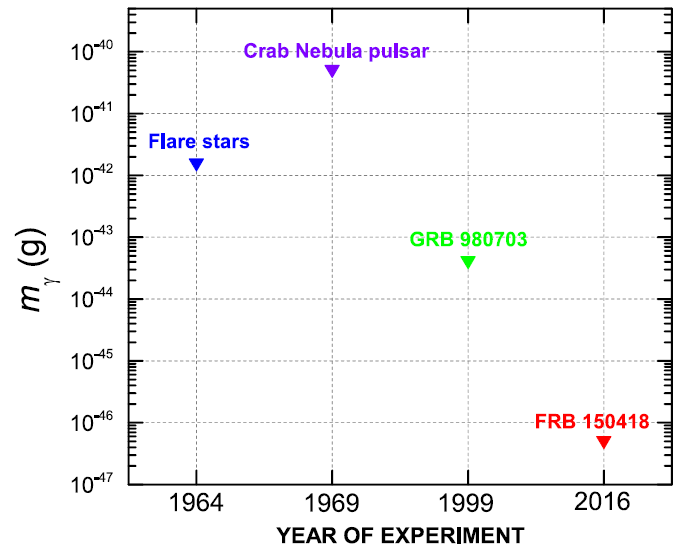The question of whether the photon has a finite rest mass is one of the most important and interesting issues in modern physics, as it is closely related to many fundamental questions such as charge conservation and quantization, the possibility of charged black holes and so on. Hence, it is need to push the constraints on the photon mass as far as possible. The most direct method of constraining the photon mass is to detect a possible frequency dependence of the speed of light. When the laboratory conditions eventually impose a limit, astronomical events afford the best opportunity for obtaining higher precision measurements on the relative speed of electromagnetic radiation at different wavelengths.

Figure 1. Strict upper limits on the photon rest mass from detection of the frequency dependence of the speed of light from astrophysical sources. The upper limits from flare stars, Crab Nebula pulsar, and GRB 980703 are taken from Lovell et al. (1964), Warner & Nather (1969), and Schaefer (1999), respectively.
Very recently, Keane et al. (2016) reported the first precise localization for a fast radio burst (FRB) thanks to the identification of a fading radio transient, providing the first redshift measurement to FRB 150418 (z = 0.492+/-0.08). The simple, sharp, temporal feature of the FRB signal allows one to easily derive the observed time delay between different frequencies. These time lags are usually small, which make FRBs one of the best candidates for constraining the rest mass of the photon. From the frequency-dependent delay of FRB 150418, we can obtain an approximate delta_t= 0.815 s delay time between frequencies nu_l = 1.2 GHz and nu_h= 1.5 GHz. In principle, the total delay time may contain several contributions, including, e.g., an intrinsic (astrophysical) time delay between two test photons, a time delay caused by effects of Lorentz invariance violation (if this exists), and a time delay from the dispersion process by the line of sight free electron content. Assuming that all of the observed time lag can be attributed to a nonzero photon mass, a conservative upper limit for mg can be estimated. As shown in Figure 1, a strict limit on the photon rest mass from FRB 150418 is mγ<5.2×10-47g, which is 103 times better than that obtained using other astrophysical sources with the same method.
This work by Xue-Feng Wu, Song-Bo Zhang, He Gao, Jun-Jie Wei et al. has been published in The Astrophysical Journal Letters.
Please see ApJL, 822, L15 (2016) for more details. (http://iopscience.iop.org/article/10.3847/2041-8205/822/1/L15/meta).
|
(Information Source: Purple Mountain Observatory, CAS) |

